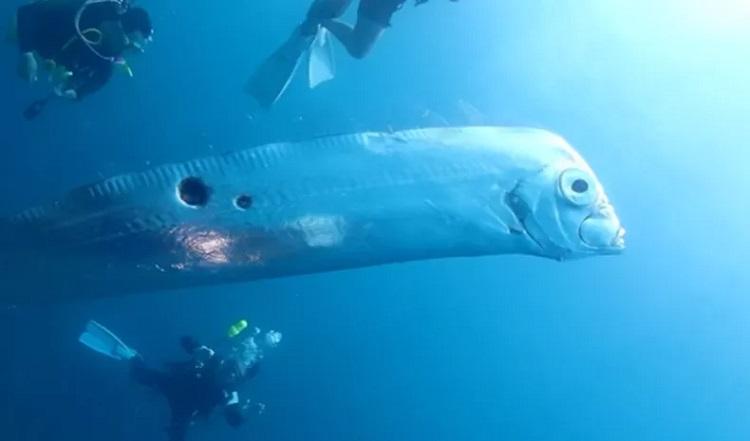Divers made a remarkable discovery off the northeast coast of Taiwan – an enormous deep-sea oarfish.
In late June, a video captured the creature, measuring over six feet long, with what looked like giant bite marks on its body.
The footage, taken by diving instructor Wang Cheng-ru near Ruifang, quickly went viral after being shared on the Instagram page “Wealth.” It showed a group of divers observing the radiant silverfish in the picturesque Ruifang region of Taipei County.
In the video, one of the divers tried to touch the fish, but it swiftly darted away. The oarfish was about 6.5 feet long, smaller than the record-breaking maximum length of 36 feet, but still an impressive sight.
We're now on WhatsApp. Click here to join.
The Guinness Book of World Records recognizes the oarfish as the longest-recorded fish in existence. However, the divers have concerns about its presence near Taiwan’s coast.
In Japanese folklore, the oarfish is known as a Messenger from the Sea God’s Palace and has gained a reputation as a harbinger of doomsday events, such as tsunamis or earthquakes, according to National Geographic.
Local legend claims that oarfish appear before natural disasters like earthquakes. For instance, six oarfish were seen before a deadly earthquake in the Philippines in 2017.
Despite its ominous reputation, Wang, who has been diving for 15 years, doesn’t see it that way. He thinks that the wounds on the giant oarfish may have been caused by a cookie-cutter shark attack.
Taiwan’s northeast coast is home to many fascinating marine animals, and the underwater views are stunning, but this was Wang’s first encounter with a giant oarfish, leaving a lasting memory in his diving experiences.
“The wounds on the giant oarfish may have been the result of a cookiecutter shark [or cigar shark] attack.
“Many amazing animals can be found off Taiwan’s northeast coast, and the views under water are very beautiful, but it was my first encounter with a giant oarfish.” Wang told Newsweek.
About oarfish
The oarfish, scientifically known as Regalecus glesne, is a fascinating and enigmatic deep-sea creature that belongs to the family Regalecidae. It is one of the longest bony fish species known to exist, and its peculiar appearance has given rise to various myths and legends throughout history.
Physical Description:
Oarfish are characterized by their long, slender, and ribbon-like bodies, which can reach extraordinary lengths. The average adult oarfish can measure anywhere from 10 to 20 feet (3 to 6 meters), but some specimens have been recorded up to a staggering 36 feet (11 meters) long. They have a silvery-blue or silver-red coloration, and their bodies are covered in small, reflective scales. Two long pelvic fins trail behind them, resembling oars, which is how they acquired their common name.
Habitat:
These elusive creatures are primarily found in the deep ocean waters of tropical and temperate regions worldwide. They tend to inhabit depths between 600 and 3,000 feet (180 to 900 meters), making them challenging to study and observe. Due to their deep-sea habitat, encounters with oarfish are relatively rare, often limited to when they are injured or come close to the surface.
Historical Significance and Myths:
Oarfish have long captured the human imagination, and their appearances near the surface have been interpreted as omens or signs of impending disasters in various cultures. In Japanese folklore, the oarfish is called “Ryugu no tsukai” or “Messenger from the Sea God’s Palace,” and it is believed to be a precursor to earthquakes and tsunamis. This belief gained traction after several instances of oarfish washing ashore or appearing near coastal regions shortly before seismic events. Such occurrences have contributed to the creature’s reputation as a mystical and ominous harbinger.
Scientific Discovery:
The scientific exploration of the oarfish is relatively recent, given its elusive nature and deep-sea habitat. The first scientific documentation of an oarfish dates back to 1772 when it was described by Norwegian biologist Peter Ascanius. Since then, researchers have occasionally encountered these creatures, often by chance or after they have been washed ashore due to injuries or illness.
Modern Understanding:
While many myths and superstitions surround the oarfish, modern science has shed light on its biology and behavior. These fish are believed to be solitary creatures, and their unusual body shape and coloration likely serve as a form of camouflage in the deep ocean environment. Oarfish are thought to be primarily planktivorous, meaning they feed on small marine organisms like plankton and small fish.
Despite increased efforts to study the oarfish, its deep-sea habitat and sporadic appearances still present challenges for researchers. Nevertheless, these magnificent creatures continue to fascinate scientists and captivate the public’s imagination with their mysterious allure.





